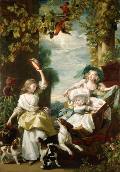King George III of England
Part 1: Early Years King George III was one of the longest-serving monarchs in the history of Great Britain and the United Kingdom. He ruled over two well-known successes, defeating France in both North America and Europe, but he also became known as the king who "lost North America" when his forces surrendered to George Washington and the Colonial Army in the Revolutionary War. A shy, retiring child, he pursued a strong interest in science and remained curious about the world around him and the heavens above for the rest of his life. He is also known for his increasingly erratic behavior, which may or may not have been caused by mental illness. He was born George William Frederick on June 4, 1738 at Norfolk House in London. His father was Frederick, who was then Prince of Wales, the heir apparent to King George II, the second Hanoverian king. George I had succeeded Queen Anne on the throne in 1714. 
Young George enjoyed a solid private education and could, from an early age, read and write in both English and German. He had a keen scientific mind and studied astronomy, chemistry, and physics in particular but also enjoyed a wider repertoire of knowledge, on subject such as agriculture, constitutional law, geography, history, mathematics, and music. He had a good understanding of two other languages, French and Latin. Not only an academic child, George was an active one, excelling in fencing and riding and even dancing. 
His father died in 1751, and young George became Duke of Edinburgh; his grandfather took a liking to him and named him the Prince of Wales, making him the heir to the throne. Nine years later, when young George was just 22, his grandfather died. Thus was crowned King George III in 1760. The next year, he married Charlotte, Prince of Mecklenburg-Strelitz. They encountered each other for the first time when they married, but they remained so for 57 years and had 16 children together. In 1762, George III bought Buckingham House for his family to use. (This became Buckingham Palace. The king and his family became known several years later for taking family holidays in Weymouth, in Dorset; this became one of England's first seaside resorts. George was quite happily married and didn't understand why others found the need to stray outside their marriages. He was deeply pious, a result of his many early years at home with his devout mother. He held himself and his subjects to high moral standards and in 1772 proclaimed the Royal Marriage Act, which required members of the royal family to get the king's consent before getting married. For his first Prime Minister, the new king selected one of his tutors, John Stuart, the 3rd Earl of Bute. They both believed in the divine right of kings, an idea that had found favor in earlier centuries but, in the late 18th Century, stood in stark contrast to the ideas of equality and social contract being advanced by John Locke and other philosophers in the Enlightenment, a period of intense introspection and cultural awakening in Great Britain and across Europe. The king also had a preference for thrift that extended not only to the royal family's expenses but also the country's expenses. The need to pursue both of those royal prerogatives would lead to conflict not only within the country but without, in the colonies, most notably North America. It was there that the British Army won a resounding victory over French and Native American forces in what the American colonists called the French and Indian War. This conflict raged in 1754–1763 and roughly coincided with the Seven Years War, a wider conflict that took place from 1756 to 1763 in Continental Europe. Next page > Wars and Legacy > Page 1, 2 |
|
Social Studies for Kids
copyright 2002–2025
David White




